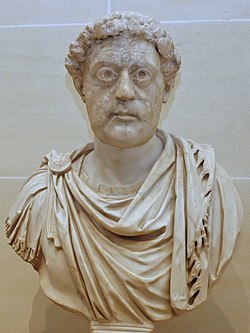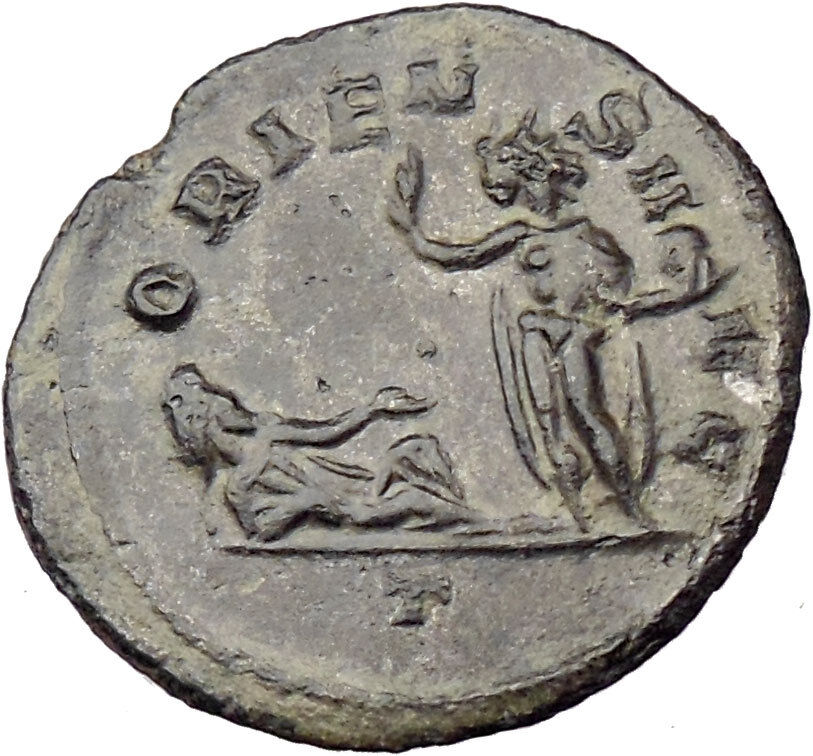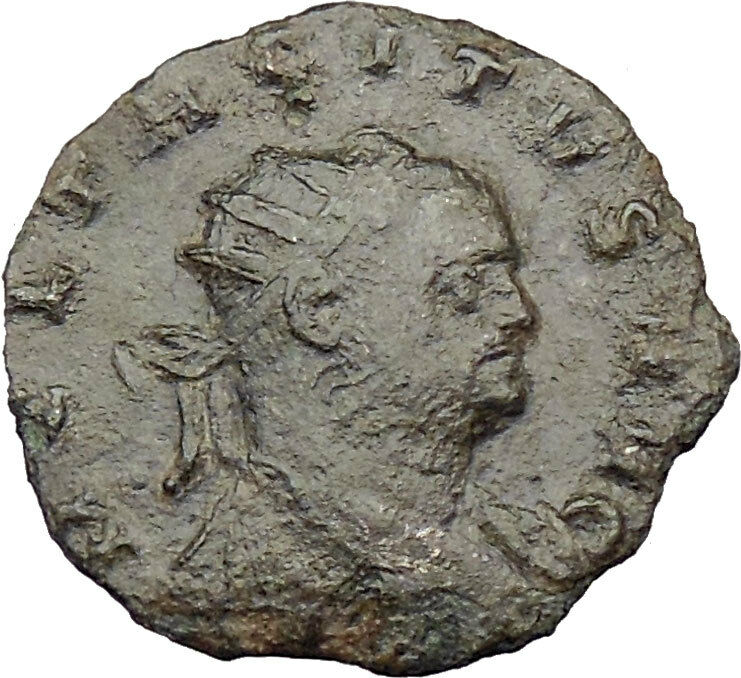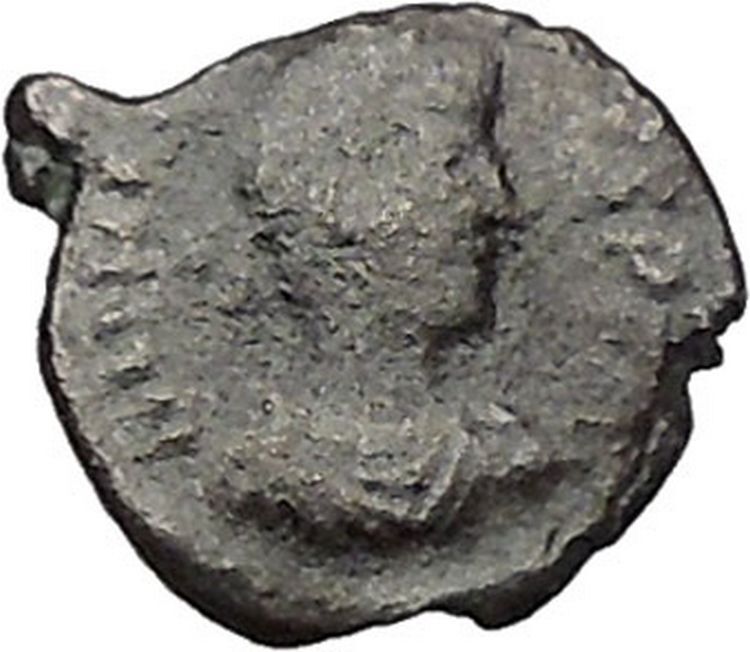|
Leo I – Roman Emperor: 457-474 A.D. –
Bronze
AE4 10mm (0.81 grams) Constantinopolis mint 457-474
A.D.
Reference:
RIC 718, LRBC 2274
DNLEOPERPET – Diademed, draped and cuirassed bust right.
No legend – Verina standing, facing, holding cross on globe and scepter; b E
across fields.
You are bidding on the exact item pictured,
provided with a Certificate of Authenticity and Lifetime Guarantee of
Authenticity.
Aelia Verina (died 484) was the Empress consort of
Leo I
of the
Byzantine Empire
. She was a sister of
Basiliscus
. Her daughter
Ariadne
was Empress consort of first
Zeno
and then
Anastasius I
. Verina was the maternal
grandmother of
Leo II
.

Family
The origins of Verina and her brother
Basiliscus
are unknown. They are considered
likely to have ancestry in the
Balkans
[1] but nothing more specific is known. They are assumed to
have at least one sister as a hagiography of
Daniel the Stylite
names a brother-in-law of
Verina and Basiliscus as Zuzus.[2]
Stefan Krautschick in his historical work Zwei Aspekte des Jahres 476
(1986) advanced a theory that the two siblings were related to
Odoacer
, the first barbarian
King of Italy
.[3]
The theory relies on passage 209.1 in the fragmentary chronicle of
John of Antioch
, a 7th century monk. The
chronicler has been tentatively identified with
John of the Sedre
,
Syrian Orthodox Patriarch of Antioch
from 641
to 648.[4]
The passage records the assassination of
Armatus
by
Onoulphus
. Based on interpretation Odoacer was
brother to either Onoulphus alone or to both men. The second interpretation was
introduced by Krautschick and has gained the support of (among others)
Alexander Demandt
and
Patrick Amory
. Armatus was identified as nephew
of Verina and Basiliscus in other Byzantine sources, including a
hagiography
of
Daniel the Stylite
[5] and the
Suda. The theory would make both Onoulphus and Odoacer nephews of
Verina and Basiliscus.[3]
However a counterargument to the theory is given by
Penny Macgeorge
in her own study Late Roman
Warlords (2003), pages 284-285, based on the silence of both
John Malalas
and
Malchus
on a blood relation of Odoacer to the
House of Leo
. Both historians were
chronologically closer to the recorded events than John of Antioch.
If accepted the theory of Krautschick would give Verina a
barbarian
origin. Her ancestry would still be
uncertain due to contradictory accounts on the ancestry of Odoacer. Various
sources have identified him as one of the
Goths
, the
Rugians
, the
Scirii
and the
Thuringii
.[3]
All four were
Germanic peoples
, with the Goths, Rugians and
Scirii grouped by ethnologists within the
East Germanic tribes
. His father
Edeko
was leader of the Scirii but it is
unclear if he was born in the tribe or married into it. Other sources identify
Edeko as one of the Huns
, possibly because of his service under
Attila the Hun
.[3]
According to Amory, the varying ethnographic identities of both men may reflect
both their mixed ancestry and their political association with the various
groups.
The presence of Verina in the Roman court has been attributed by Demandt to
“the osmosis of the late Roman and Germanic aristocracies”. In other words the
practice of intermarriage between the Roman military aristocracy and the
dynasties derived from it on the one hand and various Germanic families of
foederati
.[3]
Marriage
Verina married Leo, a
Thraco-Roman
officer of the
East Roman army
. According to
Jordanes
and
John Malalas
, her husband was one of the
Bessi
, a tribe of
Thracians
.
Theodorus Lector
,
Theophanes the Confessor
,
Georgios Kedrenos
and
Michael the Syrian
report Leo born in
Thrace
. However the
Bibliotheca
of
Patriarch Photios I of Constantinople
quotes
Candidus
in placing his birthplace in
Dacia
.[6]
Leo was not from a prominent family. His only known relation prior to his
marriage was a sister named Euphemia. According to Patria, attributed to
George Codinus
, Euphemia never married. She
resided in
Constantinople
and was visited by her brother
on a weekly basis. She reportedly erected a statue in honor of her brother. The
Prosopography of the Later Roman Empire
notes
that the source is not considered particularly reliable.[6]
The Patria was written during the reign of
Basil II
(976–1025) and revised during the
Alexios I Komnenos
(1081–1118). So at least
five centuries separate the time of Leo and Euphemia and this written account of
their relationship.
Verina and Leo had three children. Their eldest daughter
Ariadne
was born prior to the death of
Marcian
(reigned 450–457).[7]
Ariadne had a younger sister,
Leontia
. Leontia was first betrothed to
Julius Patricius
, a son of
Aspar
, but their engagement was probably
annulled when Aspar and another of his sons,
Ardabur
, were assassinated in 471. Leontia then
married
Marcian
, a son of
Anthemius
and
Marcia Euphemia
. The couple led a failed revolt
against Zeno in 478–479. They were exiled to
Isauria
following their defeat.[6]
An unnamed son was born in 463. He died five months following his birth. The
only sources about him are a
horoscope
by
Rhetorius
and a
hagiography
of
Daniel the Stylite
.[6]
Empress consort
In January, 457 Marcian succumbed to a disease, allegedly
gangrene
. He was survived by his daughter
Euphemia and his son-in-law
Anthemius
.[8]
Leo was at this point the
tribune
of the Mattiarii, a regiment wielding
the mattea (Latin
for mace
) as their weapon.
Marcian had been proclaimed an
Augustus
as consort of
Pulcheria
, a member of the
Theodosian dynasty
. With his death the dynastic
succession ended. His only daughter was from a previous marriage and thus not
considered heiress to the dynasty. The
Byzantine army
and the
Byzantine Senate
had to elect a new Augustus.
Aspar
, the
magister militum
(“Master of soldiers”) of the
Eastern Roman Empire
, was unable to claim the
throne for himself due to his origins and religious affiliations.[9]
He was one of the Alans
, a
Sarmatian
tribe. Though his family had served
in the Roman military for generations, Aspar was still considered a barbarian.
He was also an adherent of
Arianism
while the majority of the ruling class
of the Eastern Roman Empire had accepted the
Nicene Creed
. Therefore an unpopular choice for
the throne.
Aspar used his influence in order to be become a
kingmaker
. He was able to pick a candidate
among his own subordinate officers, probably counting on their continued
loyalty. He chose Leo and the Senate accepted the choice.[9]
On 7 February 457, Leo was crowned by
Patriarch Anatolius of Constantinople
, the
first such coronation known to involve a Patriarch.[7]
At this point Verina became the Empress consort. She probably added “Aelia”
to her name at her proclamation as an Augusta. The name had become standard for
Augustas of the Theodosian dynasty.[10]
In 461, Leo founded the
Excubitors
as a counterbalance to the
Germanic
soldiers under Aspar. He recruited the
majority of its members from among the sturdy and warlike Isaurians. In 466,
Tarasicodissa, an Isaurian officer of the Excubitors came forth with evidence
that Ardabur
, a son of Aspar, was guilty of
treason
.[11]
The scandal caused a rift in the relations of Leo and Aspar, leaving the former
relying even more on the Excubitors.
In 467, the alliance of Leo and Tarasicodissa was sealed with the marriage of
Ariadne to the officer. To make himself more acceptable to the Roman hierarchy
and the native
Greek-speaking
population of
Constantinople
, the new son-in-law of the
imperial couple changed his name to Zeno. Their only known son of Ariadne and
Zeno,
Leo II
, was born within the year.
In 471, Aspar and Ardabur were murdered within the
Great Palace of Constantinople
by orders of
Leo. Leo earned the
nickname
“Macelles” (the
Butcher
) for the manner of the deaths.[6]
Zeno was left by default as the main supporter of Leo within the
Byzantine army
.[7]
Leo II was proclaimed
Caesar
in October, 473 and effectively became
the designated heir to the throne. By virtue of being the closest male relative
of Leo I. On 18 January 474, Leo I died of
dysentery
. Their grandson immediately succeeded
him.[12]
Verina remained at the Palace.
Widowed empress
Since Leo II was too young to rule himself, Verina and Ariadne prevailed upon
him to crown Zeno as co-emperor, which he did on February 9, 474. When Leo
became ill and died on November 17, Zeno became sole emperor with Ariadne as his
Empress consort.
Verina was not content in the role of a widow. According to both Candidus and
John of Antioch, she found a lover in the person of Patricius, a former
Praetorian prefect
.[10]
Verina had originally supported Zeno while the young emperor Leo II was still
alive. Not long after her grandson’s death, Verina turned against her
son-in-law.
John Malalas
attributes her hostility to an
argument between them over a request the senior Augusta had made on her
son-in-law. Malalas does not clarify what was the request. A modern
interpretation suggests that the request concerned her second marriage to
Patricius. Which Zeno had reasons to refuse to prevent Patricius from emerging
as a rival candidate for the throne.[10]
Verina conspired against Zeno with her lover Patricius, her brother
Basiliscus
, the
Isaurian
general
Illus
, and general
Theodoric Strabo
, forcing Zeno to flee
Constantinople
in 475. Verina, who fomented a
popular revolt against the emperor. The uprising, supported by Theodoric Strabo,
Illus and Armatus, was successful, and Verina convinced the emperor to leave the
city. Zeno fled to his native lands, bringing with him some of the Isaurians
living in Constantinople, and the imperial treasury. Basiliscus was then
acclaimed as Augustus on 9 January 475[13]
at the
Hebdomon
palace, by the palace ministers and
the Senate.
John of Antioch and the hagiography of
Daniel the Stylite
imply that Verina was
tricked in supporting the conspiracy. Candidus and John of Antioch report that
Verina was hoping to use the conspiracy to replace Zeno with Patricius.
Restoring herself to the position of Empress consort in the process. Yet,
Basiliscus was crowned as soon as Zeno had abandoned the city. According to
Malalas, Verina had to crown Basiliscus herself as the only person of imperial
rank present within the capital. There is some doubt whether the description of
Verina’s motivation by Candidus and John of Antioch was accurate or reflecting
the hostility of the chroniclers to her.[10]
Whatever the case, Patricius served early in the new reign as the
Magister Officiorum
. Eventually, Basiliscus
ordered the death of Patricius, as the officer was a natural candidate to
overthrow the new emperor; as a consequence, Verina later intrigued against
Basiliscus, because of her lover’s execution.[14]
According to Candidus
, after the death of Patricius, Verina
intrigued in favour of Zeno, but her plan was discovered by Basiliscus, and only
the intercession of Armatus spared her life.[10]
In 476, both Illus and Armatus defected to the side of Zeno In August, Zeno
besieged Constantinople. The leader of the
Pannonian
Goths, Theodoric the Amal (later
known as
Theodoric the Great
) had allied to Zeno.
Theodoric would have attacked Basiliscus and his Thracian Goth
foederati
led by Theodoric Strabo,
receiving, in exchange, the title of magister militum held by Strabo and
the payments previously given to the Thracian Goths. It has been suggested that
Constantinople was defenseless during Zeno’s siege because the Magister
Militum Strabo had moved north to counter this menace. The Senate opened the
gates of the city to the Isaurian, allowing the deposed emperor to resume the
throne. Ariadne still being his Empress consort.
Rivalry with Illus
The brief reign of Basiliscus does not seem to have resulted in lasting
hatred between Verina and either Zeno or Ariadne. However it did result in
hatred between Verina and Illus. The hagiography of Daniel the Stylite considers
Illus responsible for pulling Verina into the initial conspiracy while hiding
its actual goals. Directly or indirectly responsible for the death of Patricius.[10]
In 477, a first assassination attempt on Illus was contacted by a
slave
. Though primary sources do not associate
Verina with the first attack, later historians have suggested this was the case.
In 478, a second assassination attempt on Illus was contacted by Epinicus, a
long-time favourite of Verina. Epinicus allowed Illus custody of the prisoner
and the interrogation resulted in a confession implicating Verina in the plot.[10]
Illus recuperated from the attack in his native Isauria. He reportedly
refused to return to Constantinople with Verina still residing in the Palace.
Zeno agreed to banish her from the capital. She indeed never returned during her
life. According to John of Antioch, Verina was at first confined in a monastery
located at
Tarsus
. She was then sent first to
Dalisandus
(two namesake cities existed in
Isauria and Pamphylia
) and secondly to Cherris in Isauria.[10]
In 478-479, the revolt of
Marcian
, a son of
Anthemius
took place. He was married to Leontia,
the second daughter of Leo I and Verina. His claim to the throne relied on his
wife being a
Porphyrogenita
. In theory Leontia outranking
her older sister Ariadne who was born previous to the elevation of her parents
to the throne. Marcian and his brothers Procopius and Romulus launched their
coup d’état
in Constantinople. They were
besieging the palace when Illus arrived with reinforcements from
Chalcedon
. John of Antioch attributes the
entire revolt to Verina but the actual extent of her involvement is uncertain.[10]
In 480, Verina was still confined in Isauria under the custody of Illus.
However she was able to correspond with Ariadne and convinced her daughter to
intervene on her behalf. Ariadne endeavoured to obtain her release, first from
Zeno, and then from Illus, to whom the emperor referred her. Illus not only
refused her request, but charged her with wishing to place another person on her
husband’s throne. This irritated her; and she, like her mother, attempted to
assassinate Illus.
Jordanes
ascribes her hatred to another cause:
he says that Illus had infused jealous suspicions into Zeno’s mind which had led
Zenoan attempt on her life, and that her knowledge of these things stimulated
her to revenge. The assassin whom she employed failed to kill Illus, but cut off
his ear in the attempt. The assassin was taken, and Zeno, who appears to have
been privy to the affair, was unable to prevent his execution.[10][15]
Alliance with Illus
In 483 or 484, Illus rose in rebellion against Zeno. Verina still had her
imperial rank and so could still crown another Augustus. He released her from
confinement and had her crown
Leontius
, a general, as an Augustus in Tarsus.[10]
The revolt also had religious meaning as the rebels were
Chalcedonian
Christians while Zeno was an
adherent of
Monophysitism
.[16]
John Malalas describes that Verina joined the new alliance with fervor,
corresponding with various cities and trying to win their support for the
revolt. However there is some doubt over the sincerety of both her new
convictions and her political “friendship” with her old enemy. She may in effect
have still been Illus’ prisoner and acted under his command to preserve her
safety. She notably did not join Leontius and Illus in their campaign for
Antioch
but was sent to the fortress of
Papirius in Isauria.[10]
The revolt failed to gain sufficient support and the rebels had to withdraw
from Antioch back to Papyrius. Zeno sent an army including both Romans and
Ostrogoths
under
John the Scythian
which managed to defeat them.
The fort was besieged from 484 to 488. Verina died early in the siege
[16]
Whether her death was violent or not
is uncertain. According to Malalas, when the siege ended the corpse of Verina
was recovered and sent to Ariadne for burial.[10]
Possible descendants
The Georgian Chronicle, a 13th century compilation drawing from
earlier sources, reports a marriage of
Vakhtang I of Iberia
to Princess Helena of
Byzantium, identifying her as a daughter of the predecessor of Zeno.[17]
This predecessor was probably Leo I, the tale attributing a third daughter to
Verina.
 Flavius Flavius
Valerius Leo (401–18 January 474), known in English as Leo the Thracian or Leo
I, was a Byzantine Emperor who ruled from 457 to 474. He was known as Magnus
Thrax (the “Great Thracian”) by his supporters, and Leo the Butcher by his
enemies.
Ruling the Eastern Empire for nearly 20 years from 457 to 474, Leo proved to be
a capable ruler, overseeing many ambitious political and military plans, aimed
mostly for the aid of the faltering Western Roman Empire and recovering its
former territories. Born as Leo Marcellus in the year 401 to a Thraco-Roman
family (of the Daci[1][2] or Bessi[3] tribe), he served in the Roman army,
rising to the rank of count (comes). He was the last of a series of emperors
placed on the throne by Aspar, the Alan serving as commander-in-chief of the
army, who thought Leo would be an easy puppet ruler.
Leo’s coronation as emperor on February 7 457 [4], was the first known to
involve the Patriarch of Constantinople[5]. Leo I made an alliance with the
Isaurians and was thus able to eliminate Aspar. The price of the alliance was
the marriage of Leo’s daughter to Tarasicodissa, leader of the Isaurians who, as
Zeno, became emperor in 474. In 469 Aspar attempted to assassinate Zeno[6], and
very nearly succeeded. Finally in 471 Aspar’s son Ardabur was implicated in a
plot against Leo and both were killed by palace eunuchs acting on Leo’s orders.
During Leo’s reign, the Balkans were ravaged time and again by the East Goths
and the Huns. However, these attackers were unable to take Constantinople thanks
to the walls which had been rebuilt and reinforced in the reign of Theodosius II
and against which they possessed no suitable siege engines.Leo’s reign was also
noteworthy for his influence in the Western Roman Empire, marked by his
appointment of Anthemius as Western Roman Emperor in 467. He attempted to build
on this political achievement with an expedition against the Vandals in 468,
which was defeated due to arrogance of Leo’s brother-in-law Basiliscus. This
disaster drained the Empire of men and money. The expedition, which cost 130,000
pounds of gold and 700 pounds of silver, consisted of 1,113 ships carrying
100,000 men, but in the end lost 600 ships.
Leo’s greatest influence in the West was largely inadvertent and at second-hand:
the great Goth king Theodoric the Great was raised at Leo’s court in
Constantinople, where he was steeped in Roman government and military tactics,
which served him well when he returned after Leo’s death to become the Goth
ruler of a mixed but largely Romanized people.
Leo died of dysentery at the age of 73 on January 18, 474.Leo and Verina had
three children. Their eldest daughter Ariadne was born prior to the death of
Marcian (reigned 450 – 457). [7]. Ariadne had a younger sister, Leontia. Leontia
was first married to Patricius, a son of Aspar. Their marriage was probably
annulled when Aspar and another of his sons, Ardabur, were assassinated in 471.
Leontia then married Marcian, a son of Anthemius and Marcia Euphemia. The couple
led a failed revolt against Zeno in 478-479. They were exiled to Isauria
following their defeat. [8]
An unnamed son was born in 463. He died five months following his birth. The
only sources about him are a horoscope by Rhetorius and a hagiography of Daniel
the Stylite. [9]
The Georgian Chronicle, a 13th century compilation drawing from earlier sources,
reports a marriage of Vakhtang I of Iberia to Princess Helena of Byzantium,
identifying her as a daughter of the predecessor of Zeno. [10]. This predecessor
was probably Leo I, the tale attributing a third daughter to Leo. Cyril
Toumanoff identified two children of this marriage. Mithridates of Iberia and
Leo of Iberia. This younger Leo was father of Guaram I of Iberia. The accuracy
of the descent is unknown.
|






 Flavius
Flavius 


